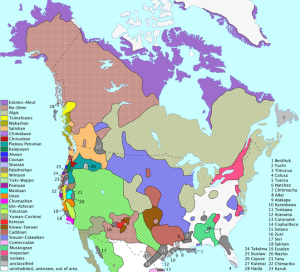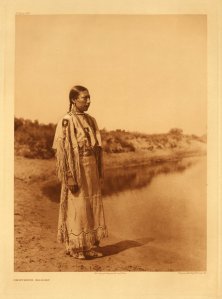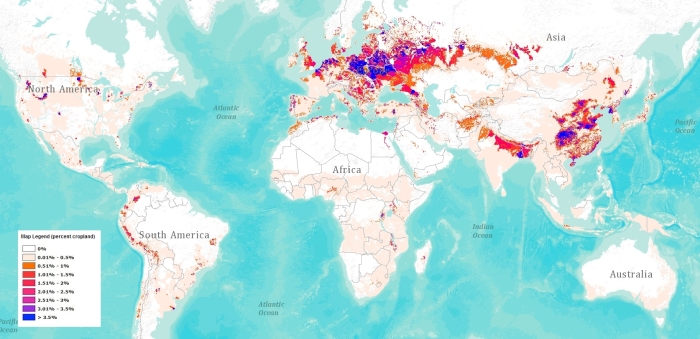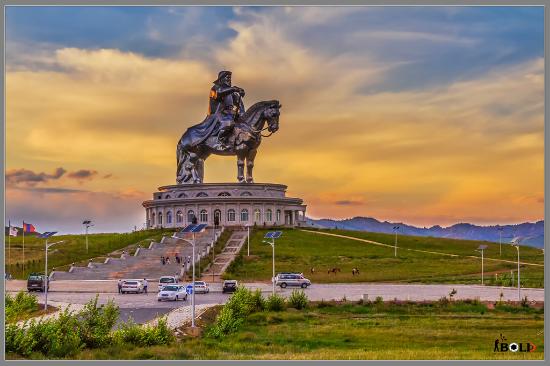Welcome back to our discussion of Legal Systems Very Different from Ours. I know we normally hold book club on Mondays, but since I spent most of Monday just laying the groundwork necessary to be able to discuss Comanche, Cheyenne, and Kiowa law, today we’ll actually jump into the subject.
Notably, the nomadic plains Indian lifestyle was not some ancient way of living the Indians had followed since time immemorial, but an essentially new invention enabled by the importation of the horse. Comanches started out as hunter gatherers and maybe sporadic horticulturalists in the Great Basin (Utah, more or less.) The Kiowa started out near the Canadian boarder in western Montana. They’re related to agriculturalists, but probably weren’t farming up in the black hills. And the Cheyenne hailed originally from the other side of the continent, descended from agriculturalists who were driven out of their homes by other Indians who’d gotten guns from the settlers. The Cheyenne also have a tradition stating that they intentionally decided to stop being farmers and become nomads; the other two groups were likely already nomadic before they got horses.
The authors write:
Faced with a sudden opportunity for progress, the chance to stop scratching in the earth as primitive agriculturalists and turn into noble savages hunting buffalo living in tipis and proving their manhood by making war on each other, the Indian tribes living on or near the Great Plains seized the opportunity.
Obviously I question whether the Comanche were ever agriculturalists, but the Cheyenne probably were. A better question is what happened to the other agriculturalist/horticulturalist peoples near the edges of the Great Plains like the Mississippian peoples, whose cities had largely disappeared by the time American settlers reached them.
Anyway:
The result was the development in the eighteenth century of a common material culture shared by tribes with quite different origins. It depended on the horse but also made good use of the rifle rifles having been initially provided by the English to tribes willing to fight tribes allied with the French and by the French to tribes willing to fight those allied with the English.
One thing I noticed while researching this chapter is that the eventual triumph of the settlers in the late 1800s by no means seemed guaranteed in 1800. Once they got ahold of horses and guns, the Indians held their own against American and Spanish/Mexican settlers for over a hundred years. Their eventual defeat was due to a combination of the railroad, increased wartime production of guns during the Civil War, the steel plow, irrigation techniques that opened up the Great Plains to agriculture, and overwhelming quantities of European immigrants that just kept flowing into the US. (Oh, and diseases.)
But anyway:
I start with the Comanche; their government is the simplest of the three to describe, since they did not have one. A Comanche war chief was simply an entrepreneur a warrior who announced his intent to go steal horses from the Mexicans Americans, or some other tribe and invited anyone interested to come along. Within the war party he had absolute rule, but anyone unhappy with the situation was free to leave.
I note that the Comanche seem likely to have had the simplest social structure before they obtained horses, so this might account for their simplicity after moving onto the plains.
In addition to peace chiefs and war chiefs, there was also a council.
The council consisted of respected elders whom everyone simply agreed were held in respect; there was no formal process for joining the council, nor any formal process for implementing the council’s decisions.
Generally the majority made little effort to impose its will on the minority, for, as in most Indian tribes, it was thought that agreement should be unanimous.
When your lifestyle involves riding horses around on the open plains at will, it is hard to impose your will on anyone because it is hard to catch them. If they don’t like you, they’ll just move away and go hunt somewhere else.
The Comanche, in other words were anarchists. Their social system included institution for coordination at the level of the individual band but nothing we would recognize as a government over either the band or the entire tribe.
The authors note that one of the theoretical problems with an anarchist society is convincing everyone to pay enough to contribute to the common defense; the Comanche solved this problem by making “providing for the common defense” extremely profitable to the individual–mostly by stealing their enemy’s stuff, raping their women and torturing the men to death.
I mean, it’s a solution, sure, but it’s a solution that didn’t exactly inspire their neighbors not to massacre them when they could.
Still, I’d like to contrast Comanche warfare–which probably bears a close resemblance to warfare as typically conducted throughout human history, plus or minus the horses and guns–with modern warfare. The US has been in many wars over the years, but hasn’t actually held onto any of the land it conquered since, well, the Indian wars (which we hardly even recognize as real wars). We conquered Cuba and the Philippines in the Spanish American War, but we no longer own these territories. We conquered big chunks of Europe and Asia in WWs I and II, but we gave France back to the French and Japan back to the Japanese. We gave South Korea back to the South Koreans and have basically tried to return Afghanistan and Iraq to local rule.
There might be some government fat cats or weapons contractors who make money off these wars, or they might potentially benefit us all in some grand, abstract way that you can’t really pinpoint in your daily life, but no common American has benefited from these conflicts in the direct, immediately obvious way of an Irish raider carrying off his neighbor’s cattle or a Comanche stealing another man’s wife. We’ve invented the concept of “just war,” and it seems that everyone hates it.
[The Comanche] drove the Apache from the southern plains raided the Mexicans for horses and slaves and, despite the disadvantage of lower technology and smaller population, blocked American expansion across Texas for decades, fairly earning the title of Spartans of the plains.
In this case, it’s not about tech, it’s about mobility and the ability to survive largely off theft.
… they made warfare into a private rather than a public good. for most of their history, the incentive to fight was not the welfare of the tribe but the individual warrior. Successful raids produced valuable loot. Heroic and successful fighting produced status.
I think there is still some status in being a soldier, but not much. We might say that modern governments have appropriated for themselves the spoils that would rightfully go to their soldiers.
On the other hand, modern soldiers get paid.
On wife stealing and family structures:
The strongest bond within the tribe was between brothers who, among other things, shared their wives and had the power to marry off their sisters. [Note: maybe] From the standpoint of the brother the ideal brother-in-law was a wealthy and successful warrior. The sister might prefer someone [else]… and given the opportunity, leave the husband chosen for her by her brothers to run away with one such. The incentive of the wife stealer was less possession of the wife than the opportunity to outface the husband.
Wife stealing was carried out openly, followed by demands of compensation from the original husband. Of course, with no police or prisons to enforce the demand for compensation, the only real threat the aggrieved husband can make is that of killing the thief.
Carrying out that threat was neither desired nor likely, since if the husband killed the stealer (or vice versa) the victim’s kin would take revenge by killing the killer. The intended result of the threat was to set off the game that economists call bilateral monopoly.
So each side calls up whatever resources it can to back up its threats and then one side pays up.
Of course, if a man suspected his wife of adultery, he could just torture or kill her. After all, men are stronger than women and there weren’t any police or prisons to protect them from violent spouses.
Cases of wife stealing and adultery seem to have been the nearest thing to legal disputes among the Comanche. … One possible resolution was for the wife to swear by earth an sky that she was innocent, at which point the husband accepted the oath… The same approach was used to settle some other disputes, such as disagreements as to which member of a war party had counted coup on an enemy… As far as minor theft was concerned, the Comanche, like the other two tribes I will discuss, regarded such matters as beneath the notice of a warrior. As a Cheyenne would have put it, “if you had asked, I would have given it to you.”
What we regard as extreme generosity is often noted of nomads. It’s in part due to the fact that nomads simply cannot store up large amounts of stuff. They don’t store grain for winter because they don’t farm and they have nowhere to store it. As a result, nomads–especially nomadic hunters–always face the threat of simply having a couple of bad weeks and running out of food. Nomadic economies work better when people share food (and hunting weapons) fairly freely, especially from large kills such as buffalo that a single man can’t hope to eath by himself, anyway. This doesn’t mean that people lose their sense that “This is my arrow because I made it myself,” but it does result in a lot of sharing, some voluntary, some very socially enforced.
We see as well the abundance of the nomadic lifestyle. Certainly they had fewer physical belongings than we do–since they can’t carry that much around–but what they did have, like horses and buffalo, they had in abundance. This abundance is partly due to the fact that they stole a lot of horses from other people, so they didn’t have to put in the hard work of raising them themselves, and yes, it is easy to be generous and happy when you are living off the fat of another man’s labor, and partly because they had a low population density on an open plain that was full of giant herds of delicious animals.
Low population + tons of resources = happy people.
The more people are trying to share a certain area or set of resources, the less there is to go around, the less “wealth” each person feels they have, the less freedom, less happiness, more hoarding.
From Footnote 441:
“From the liberality with which they dispose of their effects on all occasions of the kind it would induce the belief that they acquire property merely for the purpose of giving it to others.” (Neighbors 1853, 134)
I am reminded as well of a by now only vaguely remembered passage in which some missionaries or others initiating contact between the settlers and plains Indians gifted them with necklaces, beads, and other sundry products of civilization which they thought fine presents, and which the Indians happily received. Then when time came to break up camp, all of the new gifts were abandoned, trampled underfoot in the process of getting underway and left behind in the mud. Of course the missionaries probably saw this as some failure to value items of wealth or perhaps ingratitude, but to nomads who have to physically pack up and haul all of their belongings from place to place, additional stuff that doesn’t have hooves quickly acquires negative value.
The value of a gift-giving network, though, is much greater than the value of any individual item that passes through it. Through such networks travel not just trifles like beads and necklaces, but things of substantial value like food, horses, weapons, wives, or allies, so it makes perfectly reasonable sense for a man to obtain something simply for the sake of giving it away.
What about murder? As already mentioned, a first killing required a second, of the killer by the kin of his victim. At that point the matter ended. … For these purposes, killing a favorite horse, thought of as having a soul, counted as murder and so justified the killing of the responsible human in revenge.
The Comanche believed in magic and sorcery, and might kill a man believed to be killing people via lethal magic, but don’t appear to have believed in it strongly enough to make killing the sorcerer mandatory (a rare show of good sense in the ethnographic record on sorcery).
Occasionally the whole tribe might come together and decide that a particularly bad medicine man deserved to die and killed him.
The Kiowa:
The Kiowa, while in some ways similar to the Comanche, had something a little closer to a government and much closer to a well-defined class/rank system. The latter consisted of four classes. The Onde were the high-status warriors… they are estimated to have been 10% of the men. The Ondegupta were the would-be Onde… Not surprisingly, the Ondegupta were the chief source of conflict within the tribe as they… tried to gain status. Below them were the common men and below those the Dapom, the dregs of society. … Kiowa bands had recognized headmen, almost all of Onde rank, who in practice made important decisions for the band.
There were also ten “medicine bundle” keepers and one “keeper of the Sun Dance fetish,” the nominal grand chief of the tribe. In case of disputes, the medicine bundle keepers would hear out both sides and help them come to an agreement about an adequate resolution and compensation.
If someone was killed, the killer might be killed in retaliation by his victim’s kin or they might accept compensation, the equivalent to the Icelandic wergeld or the payments that atoned for killing under Islamic law or among the Somali.
This seems to be a very common pattern. It’d be interesting to see a broad cross-cultural comparison of the communities where it is (or was) common vs the ones where it isn’t.
The Kiowa and Cheyenne had military fraternities or warrior societies. Wikipedia reports:
Like other plains Indians, the Kiowa had specific warrior societies. Young men who proved their bravery, skill, or displayed their worth in battle were often invited to one of the warrior societies. In addition to warfare, the societies worked to keep peace within the camps and tribe as a whole. There were six warrior societies among the Kiowa.[24] The Po-Lanh-Yope (Little Rabbits) was for boys; all young Kiowa boys were enrolled and the group served mostly social and education purposes, involving no violence or combat. The Adle-Tdow-Yope (Young Sheep), Tsain-Tanmo (Horse Headdresses), Tdien-Pei-Gah (Gourd Society), and Ton-Kon-Gah (Black Legs or Leggings), were adult warrior societies.[25][26] The Koitsenko (Qkoie-Tsain-Gah, Principal Dogs or Real Dogs)[27] consisted of the ten most elite warriors of all the Kiowa, who were elected by the members of the other four adult warrior societies.[28]
As for the Cheyenne:
Specific warrior societies developed among the Cheyenne as with other plains nations. Each society had selected leaders who would invite those that they saw worthy enough to their society lodge for initiation into the society. Often, societies would have minor rivalries; however, they might work together as a unit when warring with an enemy. Military societies played an important role in Cheyenne government. Society leaders were often in charge of organizing hunts and raids as well as ensuring proper discipline and the enforcement of laws within the nation.[23] Each of the six distinct warrior societies of the Cheyenne would take turns assuming the leadership role within the nation.[24] The four original military societies of the Cheyenne were the Swift Fox Society, Elk Horn Scrapper or Crooked Lance Society, Shield Society, and the Bowstring Men Society. The fifth society is split between the Crazy Dog Society and the famous Dog Soldiers. The sixth society is the Contrary Warrior Society, most notable for riding backwards into battle as a sign of bravery.[6] All six societies and their various branches exist among the Southern and Northern Cheyenne Nations in present times.
The Dog Soldiers have their own Wikipedia page, with a photo of a fellow in an excellent headdress.
The Dog Soldiers or Dog Men (Cheyenne: Hotamétaneo’o) are historically one of six Cheyenne military societies. Beginning in the late 1830s, this society evolved into a separate, militaristic band that played a dominant role in Cheyenne resistance to the westward expansion of the United States in Kansas, Nebraska, Colorado, and Wyoming, where the Cheyenne had settled in the early nineteenth century.[1]
After the deaths of nearly half the Southern Cheyenne in the cholera epidemic of 1849, many of the remaining Masikota band joined the Dog Soldiers. It effectively became a separate band, occupying territory between the Northern and Southern Cheyenne. Its members often opposed policies of peace chiefs such as Black Kettle. In 1869, most of the band were killed by United States Army forces in the Battle of Summit Springs. The surviving societies became much smaller and more secretive in their operations.
Apparently they’re still around.
On to Cheyenne law:
Of the three tribes, perhaps of all the Plains Indians, the Cheyenne came closest to having a government–part of the year.
That might be because they started out as agriculturalists with a more complicated social system.
The entire tribe, possibly as many as four thousand people, gathered together in a single camp in summer when food was plentiful.
That sounds pretty nice.
During the winter the tribe separated into much smaller bands and dispersed in search of game.
The summer encampment had a government, the Council of Forty-Four as was probably necessary for coordinating 4,000 in close proximity. Once every ten years, the members of the Council chose a successor for themselves. You couldn’t name yourself as your own successor, but someone else could.
Each of the soldier societies had two chiefs, functioning as war chiefs, and two “servants,” lower-level chief responsible for a particularly dangerous part of the defense against attackers.
Of course, anyone could organize a war party if they wanted to and could get anyone to follow him.
The council was responsible for making decisions about war or peace… deciding cases of homicide or whether to permit the readmission of an exiled killer, and deciding the movements of the tribe in search of game. …
A further responsibility of Council was to control the buffalo hunt… The basic rule was that nobody was to attack a buffalo until the word was given, at which point the line of hunters would charge the herd, with the ends of the line wrapping around to entirely enclose it.
There follows a description of what happened to two lads who, being full of teenage spirit, entered the buffalo hunt before the signal was given. The tribe caught up with them, whipped them, killed their horses, and broke their guns.
The boys and their father apologized, and the tribe forgave them:
“Look how these two boys are here in our midst. Now they have no horses and no weapons. What do you men want to do about it?”
One of the soldiers spoke up. “Well, I have some extra horses. I will give one of them to them.” Then another soldier did the same thing.
Bear Standing on a Ridge was the third to speak out. “Well,” he announced, “we broke those guns they had. I have two guns. I will give them one.”
All the others said, “Ipewa, good.”
There is another interesting story about a man who borrowed a horse, then kept it for a year. When the owner finally got antsy and asked for it back, he returned it with a second horse in apology for keeping the first for so long. The original owner, having done without his horse for so long, didn’t need two, and so sent the original back to the borrower, since he seemed to like it so much.
Beating up another Cheyenne was between you and him. Killing another Cheyenne meant exile from the tribe.
The reason, as they saw it, was not punishment but hygiene. Killing a fellow Cheyenne polluted the medicine arrows that were one of the tribal fetishes… Until the arrows had been ceremonially renewed and the killer exiled, no luck could be expected in hunting or warfare.
Exile was not lethal; there were other friendly tribes on the plains.
Eventually the exiled man could return to the tribe if the victim’s kin were okay with it, but he was still seen as somewhat polluted.
Llewellyn and Hoebel see the combination of temporary exile and permanent pollution as successfully replacing feud, evidence of the superiority of the Cheyenne institutions to those of other primitive societies.
It was probably only a partial replacement, though.
So that’s the end of the chapter. Definitely more material on the Comanches than the Kiowa or the Cheyenne, but I hope it was adequate.






 Beringia is the now-lost land between Alaska and Russia that was, during the last ice age, a vast grassland. It is believed that humans lived here for thousands of years, hunting mammoths, woolly rhinos, bison, and equines. The probably fished as well, just like modern humans in the area.
Beringia is the now-lost land between Alaska and Russia that was, during the last ice age, a vast grassland. It is believed that humans lived here for thousands of years, hunting mammoths, woolly rhinos, bison, and equines. The probably fished as well, just like modern humans in the area.












